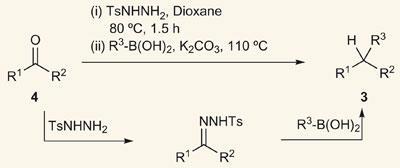Researchers develop a simple, one-pot reaction to create carbon-carbon bonds at a carbonyl group without a metal catalyst
Spanish researchers have developed a remarkably simple, one-pot reaction to create carbon-carbon bonds at a carbonyl group without the need for a metal catalyst. The method offers an environmentally friendly way to form one of the most important bonds in organic synthesis.
The technique uses hydrazone derivatives easily produced from carbonyl precursors, and boronic acids, common reagents in organic chemistry. Earlier work by the group from the University of Oviedo, Spain, had found tosylhydrazones could be coupled with aryl halides in the presence of a palladium catalyst. In this latest work they moved on to look at the possibility of reacting tosylhydrazones with boronic acids.
To begin with the team were looking at the reaction with various metal catalysts, but came across something unexpected, as team member Carlos Vald?s explains: ’When we performed the reaction with a control we discovered the reaction worked without the metal. We were very surprised at that moment.’
The team found that reactions were successful with a wide variety of functional groups attached to the tosylhydrazones and boronic acids. By mixing the relevant carbonyl compound with tosylhydrazide before adding boronic acid and base, they saw carbon-carbon bond formation could take place in one-pot without having to isolate the intermediates. The researchers believe the reaction occurs via formation of a diazo compound from thermal decomposition of the tosylhydrazone.

This simplified process would be an improvement over alternative synthetic pathways, which can be much more complex. ’We think this reaction could be important for pharmaceutical chemistry, because it is simple and the reagents are easily available and cheap,’ says Vald?s. Not having to remove traces of metal from final products is also a major advantage, reducing the risk of contamination.
Ian Fairlamb, from the University of York, UK, who develops catalytic techniques for synthetic chemistry was impressed by the study: ’Although the latest methods using palladium or iron catalysts are very efficient, the fact that no catalyst was used here is a step forward. It’s a fantastic collection of products and a breakthrough for the synthesis of heteroarylmethanes in particular.’
Tom Bond
References
et alNature Chemistry, 2009, DOI: DOI: 10.1038/NCHEM.328






No comments yet